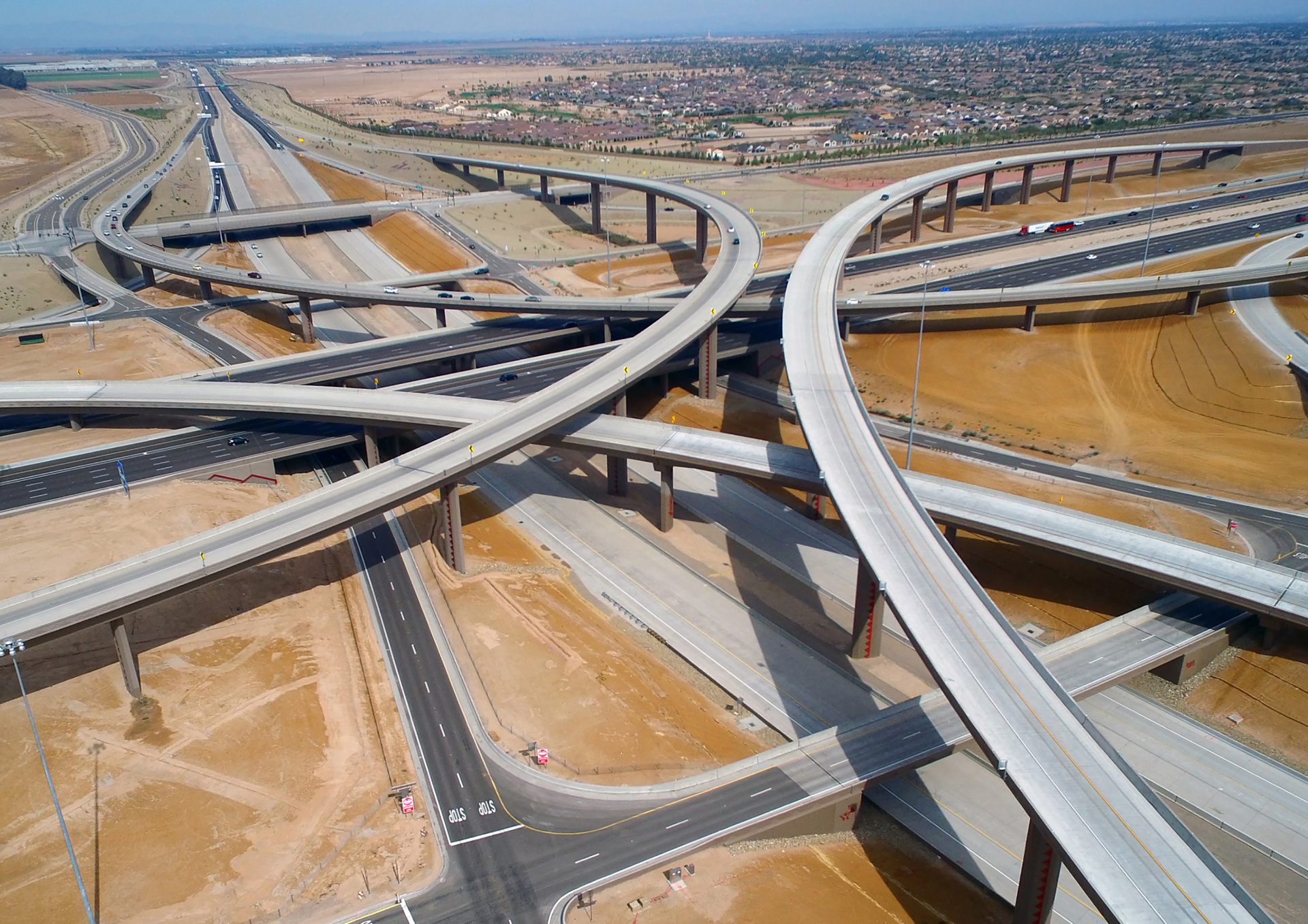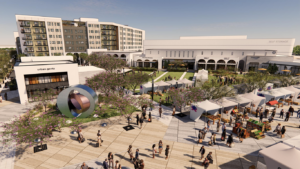The emergence of the COVID-19 virus in Arizona 18 months ago dramatically transformed almost every aspect of life and work. Retail and restaurants closed their doors, some permanently, and offices emptied as staffers pivoted to at-home employment. One thing the pandemic couldn’t stop, however, was Arizona’s commercial growth. Brokers, developers and builders reported record numbers in 2020, and 2021 has shown no signs of slowing down. Leading the way is the industrial market. According to a report by Cushman & Wakefield, in the second quarter of 2021, approximately 23.5 million square feet of industrial construction was underway across Metro Phoenix. Leasing activity and construction also remain strong. What does this all mean for the future? And what is the commercial real estate outlook for 2022?
AZRE Magazine sat down with members of NAIOP Arizona and asked for their views on how the pandemic affected the Phoenix market, how the industrial and office sectors are faring, and what their predictions are for the Valley’s recovery and continued growth.
READ ALSO: How can Arizona keep up with increased construction labor demands?
AZRE: What do you think about the rapid economic recovery, and how long will it take?



Darren Pitts: I think it’s a complicated issue with a number of significant forces that will impact economic growth. Certainly, Arizona will continue to benefit from the relocation of companies that are weary of West Coast business and tax policies and seeking a friendlier place to do business.
Jenna Borcherding: This recovery is unlike any in recent history with businesses and workers emerging with far less financial damage and at a more rapid pace. As a result, the shortages of goods, raw materials and labor are cropping up much sooner in the cycle. We are feeling some of these constraints in construction and development with long material lead times and increasing costs. Some sectors, such as industrial, never slowed down and are surpassing pre-pandemic highs; others such as retail and office are slower to recover as the behaviors of consumers and employees continue to evolve.
Mike Olsen: The V-shaped recovery that was anticipated post-pandemic is occurring. Printing 4 trillion new dollars over the past 18 months has had the desired effect, and asset prices in a number of sectors have doubled — the result of doubling the money supply. The true test will be how the markets adjust to the Fed’s tapering. From a longer-term perspective, despite the setbacks related to COVID-19, we are still experiencing the longest economic recovery in history — in year 13 perhaps. Are there still business cycles, or can asset prices rise forever? It appears to me that most asset classes are overvalued, and I don’t think that what we are experiencing today is sustainable. But no one knows from where or when the next black swan will present itself.



Chris Anderson: I think the recovery will be uneven for a while until the virus has more treatment options and more data is known about the various treatment’s longevity. Until then, we will have inflationary pressure because liquidity is at an all-time high and the supply chain is choppy at best.
Will Strong: It’s always hard to speculate on the macro economy, but I do know that Phoenix is the darling of institutional industrial investors across the U.S. and the globe. Abundant labor for corporations, relatively affordable housing, record breaking absorption and even shrinking cap rate spread to Southern California is driving some of that. More and more new investors are calling us for help getting into the market.
AZRE: What are the biggest opportunities that will exist in the Phoenix market over the next three to five years?
JB: Opportunities surrounding advanced manufacturing will be plentiful in the coming years as companies locate to the Phoenix area to support Taiwan Semiconductor Manufacturing Company (TSMC), Intel and others, further diversifying our local economy. The ripple effect will also spur demand for industrial, office, retail and housing developments across the Valley.
DP: The industrial distribution marketplace is a winner for Arizona. I think Interstate 10 and the Loop 303 will continue to be attractive alternatives for Southern California facilities. The technology and semiconductor industries bring high-paying jobs to the region. Intel leads the way, while TSMC’s new facility on I-17 is a game-changer. Competitors will follow.
MO: The positive net migration into Phoenix will benefit everyone. We have a pro-business environment, a competitive cost of living relative to other metropolitan areas, and a climate that will continue to attract people from around the world. While economic setbacks are inevitable, Arizona is a wonderful place in which invest and, over the long term, those who do so will fare well. Focusing on income-producing investments, industrial properties and for-rent residential, specifically, will continue to benefit investors, but it’s time to be very selective given where we appear to be in the cycle.
CA: We have the opportunity to build a world-class community if we can keep our tax base competitive, continue to invest in community infrastructure and be willing to redevelop areas that have fallen into neglect, for example re-using/gentrifying infill neighborhoods.
Jeff Moloznik: I think the biggest opportunities in the coming years will be in all forms of residential real estate. There will also be continued infill of mixed-use redevelopments along with creating flexible and efficient office spaces.
DP: The Valley’s demographics are changing. There is an unprecedented bubble of baby boomers retiring, and Arizona is going to be a top destination for them. I predict strong suburban housing growth in Surprise, Goodyear, Buckeye, Southwest Phoenix, Queen Creek and Pinal County. And I agree with Jeff that we’re going to see continued redevelopment. Look for many underutilized infill parcels to be redeveloped and for additional density to be added.
WS: Harnessing our rapid rental rate growth sticks out to me, as does paying attention to possible redevelopment opportunities. And, of course, getting out in front of the record-breaking leasing we are seeing take place.
AZRE: How long will expansion in the industrial market continue, and what do you think has the biggest chance of the derailing its positive trajectory?
WS: It’s really hard to speculate here, but I would be mindful of supply, construction costs and interest rates. The supply seems to be outpaced by demand with record levels of absorption. We used to do backflips if we hit 5 million square feet annually. Then we did cartwheels once we hit
8 million square feet. And now we just reported 12 million halfway through the year. Construction and interest rates tend to be a function of the market and out of everyone’s control at a local level.
MO: As I said earlier, the industrial sector is attractive but likely warrants some caution. West Valley cities, such Goodyear, that are proximate to California have the most attractive opportunity set for industrial development, but land prices are becoming a concern. And there are only so many buildings we can lease to large online retailers.

AZRE: How have the needs of industrial occupiers changed with the acceleration of the e-commerce trend?
MO: Industrial has been the new retail for several quarters. E-commerce has definitely been the main driver, and many believe we have only scratched the surface given the room for continued growth in online sales.
CA: Industrial occupiers continue to want to be closer to the end customer as well as onshore manufacturing to avoid being so dependent on foreign governments’ decision-making. E-commerce continues to improve, and the pandemic really made consumers embrace its possibilities a little faster than industry was ready. I expect that we’ll see further growth.
JB: For consumers, e-commerce has set an expectation of immediate satisfaction, so as companies evaluate their footprint, they look to be as close to the consumer as possible. This drives demand for last mile facilities and infill sites. Industrial occupiers are often faced with a decision to retrofit older buildings in infill locations versus occupying new buildings that may be farther from their customer base. This will provide even more opportunity for property owners and nimble developers.
WS: It’s not just about the consumer. Labor does not show up on a Google Earth map, but users care about workforce availability, wage rates, scalability, retention, union activity, housing and amenities. All these attributes of labor are critical in site selection and ultimately, in my opinion, where investors want to place their capital. Our leasing partners work with some of the smartest engineers I have met who quantify these factors with sophisticated studies that all end up pointing to Phoenix as ground zero.
AZRE: What has changed in industrial design to meet the needs of today’s tenants?
MO: Industrial buildings have become more technical, and the cost of fixturing some of the e-commerce structures far exceeds the shell cost. Clear heights have increased over time — 36 feet to 40 feet is becoming more of a standard for pure distribution. There are a number of uses that don’t require those levels but, to maximize flexibility, it has to be considered in spec environments. Excess land for expansion and storage is also a critical consideration for long-term adaptability.
JB: With demand for industrial space continuing to rise, the increasing cost and limited availability of industrial land forces us to think vertical. We are developing buildings with taller clear heights to increase cubic footage without having to increase the physical footprint. E-commerce tenants and fulfillment centers require far more docks per square foot compared with traditional retail supply chains, which also drives the need for more trailer parking.
AZRE: Are different industrial uses more prominent in certain submarkets? What are they?
MO: Large distribution facilities are more prominent in submarkets that are logical for regional users, such as the West Valley markets that are proximate to the Long Beach port. Last mile uses are prominent for high-density infill areas for obvious reasons. Flex industrial is prominent in areas that have more manufacturing users to accommodate small vendors that want to be close to their manufacturing clients. If you’re planning to build spec, the best advice will come from the brokers in those markets who understand the needs of the users relative to what’s currently available and what’s being planned by other developers.
WS: It does feel as though there is a trend in Sky Harbor and the Southeast Valley for larger users that resemble more bulk buildings, like those you would see in Southwest Phoenix. And Southwest Phoenix is seeing more and more Inland Empire-sized leases larger than 1 million square feet.
AZRE: Do you see industrial cap rates increasing, decreasing or remaining stable over the next year?
JB: Over the past year, we have seen significant cap rate compression in the industrial sector as a flurry of investors, who previously had not invested in the sector, looked to gain exposure. I am optimistic that we will continue to see rates decrease over the next year, but perhaps not at the same level as the prior year.
MO: The conundrum of inflation threats at the same time the 10-year
treasury rate has retreated to February 2021 levels is sending a mixed message. In 2013, the market’s reaction to impending Fed tapering, known as the “Taper Tantrum,” was opposite of what’s happening today. Investors are rushing to buy treasury bonds, causing the recent rate drop. With the 10-year essentially being a proxy of where investors think the Fed will set rates over the next 10 years, the market is implying that, despite inflation threats, there is a low probability that cap rates will rise in the near term. At the same time, it’s hard to believe there is a lot of room for cap rates to drop. So, the best odds are for a relatively stable cap rate environment.
WS: We have gone on record that Phoenix is a Tier 1 industrial market. The capital markets will reflect this more and more over time, with cap rates continuing to decrease. Investors will see for themselves the long-term value in Phoenix.
AZRE: Many businesses went to alternative work schedules during the COVID-19 pandemic. What impact will this have on demand for office space over the next year or two? How have office layouts changed given the increased attention on social distancing, flex schedules and reduced density?
MO: I think the hybrid work environment is likely here to stay for a lot of positions. At the same time, employees stacked on top of each other isn’t palatable now. While we have yet to see significant changes in office layouts, the larger national employers are formulating their plans for revised work environments. Some will require more space per head count. Others will move to hoteling to stay efficient while accommodating hybrid work schedules. Overall, it would seem that demand for office space should decline, but things tend to revert to the mean, so at some point the pandemic will be in the rear-view mirror and the pure needs of the business and its culture will be what drives a company’s office space needs.
JM: It seems as though this trend is going to be short-lived in our market. Given the lack of density throughout most of the Phoenix area, the extremes that other markets went through didn’t occur here. We are actually experiencing a boom in the office sector, which is the result of employers relocating to the Valley from those denser areas.
AZRE: What changes have office landlords had to make to existing product to attract and retain tenants?
MO: Landlords with existing office space can’t do much to modify the space their tenants are in, but there’s certainly been more attention placed on cleaner surfaces, environments and air circulation. Tenant improvement demands in our buildings with new leases negotiated and signed during the pandemic haven’t really changed.
JM: Amenities are critical when it comes to attracting and retaining tenants. It used to be commonplace for employers to want to control all aspects of their employees’ workday by providing meals, fitness facilities and entertainment opportunities within their own spaces. This changed rapidly in the past year, and the trend is definitely shifting toward more third-party-provided solutions by way of independent restaurants and fitness options.
JB: We happened to be midway through construction on a speculative office building in Chandler when COVID-19 hit. We huddled up with our team and took advantage of where we were at in the course of construction and incorporated several improvements to the building that we believed would appeal to future tenants. An outdoor amenity area for the health and well-being of employees was added, as were motion-activated doors and touch-free fixtures throughout the building. These seem to be common enhancements landlords are making to existing buildings, as well.
AZRE: Where do you see the office market being in six, 12 or 18 months?
JB: As the hybrid work model is being implemented, and companies look to bring their workforce back to the office, we will see a reduction in the amount of sublease space available on the market. Touring activity continues to increase month over month, and we are seeing a steady uptick in deal size in the office market. I’m optimistic that it will continue to get better over the next year.
MO: While there were large blocks of office space listed for sublease, much of that was a reaction from large employers that were uncertain about the lasting effects of the pandemic. Not all of it was ever intended to be sublet, but companies had to keep their options open given the uncertainty. The office prospect activity in the more popular office markets — Scottsdale, Tempe and Chandler — is surprisingly strong. While certain back-office positions may not return to the office, it’s very difficult to foster or maintain a company culture with a remote work force. While cliché, it’s true: Humans are social creatures, and most want to work in an office rather than at home. It may take longer than six to 12 months, but the office market will fully recover in a variety of forms.
JM: Monumental growth is ahead in the coming months. Both companies and individuals that never considered Phoenix found themselves here during the pandemic, and they saw the light. This is one of the most lifestyle-centric places to live and work, and now that the cat is out of the bag, the office market will continue to grow exponentially.
AZRE: What office submarkets will lead growth in the next two years?
MO: Scottsdale and Tempe will continue to dominate the Class A office markets, but the suburban office markets, including West Valley cities, will benefit from the impacts of COVID. Markets such as Goodyear, which exports 95% of its workforce to Central Phoenix and some of the East Valley cities, will see Class A office users that want to attract high-quality diverse employees who are sick of commuting. Quality of life is driving employment decisions, and employers that understand this will move or expand into markets that, to date, have not had any supply of Class A office.
CA: I agree with Michael. For the most part, suburban office markets will lead the growth as employers will want to be closer to their workforce. With employers needing to embrace some flexibility in the work week, there is still a need to have employees in the office most of the week to maintain culture and competitiveness.
AZRE: How has the COVID-19 pandemic changed the retail market, and what do you think recovery will look like over the next one to two years?
CA: The retail market was changing rapidly prior to the pandemic and will continue to evolve. Neighborhood retail will remain generally the same as consumers still need basic services. Big box, other than home improvement, will get redeveloped and need to densify with other uses, such as last mile industrial, housing and charter schools. Malls are the biggest challenge because of the way they were developed with anchors owning large swaths of the site and onerous CC&Rs (Declaration of Covenants, Conditions and Restrictions). It will take a lot of patience and capital to fix.
MO: The pandemic devastated the brick-and-mortar retail market but, with a lot of government assistance, many restaurateurs were able to hang on and re-open. There were definitely winners and losers, and that was particularly visible in the retail sectors. But overall, the tenant delinquencies have not been as bad for most retail landlords as originally projected. Subject to the unknown impact of new COVID variants, we should be back to normal within the next 18 to 24 months. Things have a tendency to revert to the mean, and I think that will be the case in this situation.
JM: The change to the retail market has been tremendous and is ever-evolving. It’s shifting more frequently than ever before. Currently, we are seeing retail sales eclipse pre-pandemic levels, which wasn’t necessarily anticipated. In the next two years, we can expect retail to continue to flourish.
DP: For many retailers, the pandemic accelerated changes in operating models, store design, online ordering and product distribution. Some retailers right-sized their fleets, while some closed their operations. Some expanded. Overall, the retail industry was extremely affected by COVID both positively and negatively. On the positive side, retailers proved to be very innovative and quick to adjust to the rapidly changing social distancing rules. An example is restaurants. Whether they are fast casual, fast food or sit-down, they were suddenly forced to service customers in their vehicles. Drive-thrus were packed, and parking lots were converted to waiting areas as store personnel delivered food to customers’ cars. From a technology standpoint, nearly every major brand modified, simplified or created online apps for customers. The result is that consumers now have many options to get what they want, when they want and where they want it. Overall, brick-and-mortar retail is alive and well, and we have confirmed that the experience of shopping in a store is not going away.
AZRE: What categories of retail tenants expanded during the pandemic, and what do you see for the next two years?
DP: In 2020, retailers in Greater Phoenix added nine grocery stores, 50 free-standing restaurants and 14 automotive buildings. Some of the larger additions include the Costco in Surprise, two Fry’s Marketplace stores and one Safeway in the East Valley, Lifetime Athletic at the Biltmore, Sprouts in Laveen and four Aldi locations throughout the Valley.
For the future, we will see more free-standing retail buildings with personal services and restaurants. The categories of home improvement, home decor and remodeling, and furniture are all experiencing gains in sales. The development of sizeable shopping centers has largely curtailed, except for two areas: In Surprise, along the Loop 303 corridor near the Costco, a large power center is planned with other land parcels also attracting new retail development. Queen Creek will also be expanding with a Costco and accompanying retailers planned at Queen Creek Road and Ellsworth Road.




